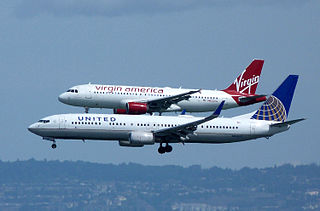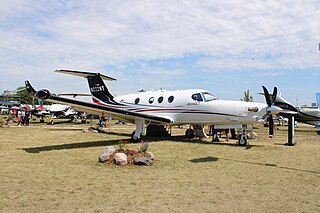




Business aircraft are aircraft typically used by companies and corporations to transport people or goods related to the needs of said businesses. Most business aircraft are general aviation aircraft variants of piston or turboprop or business jets.





Business aircraft are aircraft typically used by companies and corporations to transport people or goods related to the needs of said businesses. Most business aircraft are general aviation aircraft variants of piston or turboprop or business jets.
With the growth of general aviation in the 1930s companies started to purchase single and twin-engined aircraft for business use.
A need to move goods and equipment made use of different general aviation aircraft and surplus military transports. In 1963 in the United Kingdom the Maidenhead Organ Studios purchased a twin-engined Beagle B.206 to allow them to deliver electronic organs. [2]
For the first half of 2018, while business jets deliveries were relatively flat, new turboprops were up 10%, pressurized ones were up 12%, and King Airs were up 30%. Charter membership Wheels Up, operated by Gama Aviation, saw its flight hours surge by 18% and expanded its fleet from 99 to 117 with most of the new aircraft being examples of the Beechcraft King Air 350i. From a fleet of 63 King Airs in 2017, Wheels Up is aiming for a fleet of 1,000 serving 75,000 members in North America and Europe by 2030. [3]
The first single-engine business turboprop was the 300 kn (560 km/h), 700 hp (520 kW) Socata TBM first delivered in August 1990, followed by the 1,200 hp (890 kW) Pilatus PC-12 certificated in March 1994 with a larger cabin than a King Air 200. Piper was next with the cheaper, 500 hp (370 kW) Piper Meridian M500 debuted in September 2000, then the 600 hp (450 kW) M600, and the Epic E1000, faster than the TBM, and the Cessna Denali, competing with the PC-12, should follow soon. By May 2019, more than 3,000 single turboprops had been delivered: over 780 TBMs, over 1,600 PC-12s and over 700 turboprop Meridians. [4]
The first jet aircraft to be used as a business aircraft was the four-seat Morane-Saulnier MS.760 Paris based on military requirements as a liaison aircraft. It was followed by the four-engined Lockheed JetStar in 1957, although it was also designed to meet military requirements it was ordered by corporations like Gulf Oil, Continental Oil and Ford Motor Company. It was later followed in the mid-sixties by bespoke business jets like the six passenger Learjet 23 and the eight-passenger De Havilland DH.125.
They were followed in 1966 by larger 19-seat aircraft like the Gulfstream II based on the earlier turboprop Gulfstream I. The first generation of business jets provided speed and altitude but not the range and comfort that a larger cabin volume would give. Early Gulfstream IIs were delivered to Coca-Cola Company and Gillete. The first single-engine jet used for business use was the Cirrus Vision SF50, first delivered in December 2016.
Companies also operate airliners or freight aircraft, either new aircraft such as the Boeing BBJ family or former airliners like the Boeing 727 or Boeing 757.
With the introduction of more reliable helicopters at the end of the Second World War like the Bell 47 companies started to purchase them for executive and staff travel.
Beechcraft is an American brand of civil aviation and military aircraft owned by Textron Aviation since 2014, headquartered in Wichita, Kansas. Originally, it was a brand of Beech Aircraft Corporation, an American manufacturer of general aviation, commercial, and military aircraft, ranging from light single-engined aircraft to twin-engined turboprop transports, business jets, and military trainers. Beech later became a division of Raytheon and then Hawker Beechcraft before a bankruptcy sale turned its assets over to Textron. It remains a brand of Textron Aviation.

A turboprop is a turbine engine that drives an aircraft propeller.

An airliner is a type of airplane for transporting passengers and air cargo. Such aircraft are most often operated by airlines. The modern and most common variant of the airliner is a long, tube shaped, and jet powered aircraft. The largest of them are wide-body jets which are also called twin-aisle because they generally have two separate aisles running from the front to the back of the passenger cabin. These are usually used for long-haul flights between airline hubs and major cities. A smaller, more common class of airliners is the narrow-body or single-aisle. These are generally used for short to medium-distance flights with fewer passengers than their wide-body counterparts.

A business jet, private jet, or bizjet is a jet aircraft designed for transporting small groups of people, typically business executives and high-ranking associates. Business jets are generally designed for faster air travel and more personal comfort than commercial aircraft, and may be adapted for other roles, such as casualty evacuation or express parcel deliveries, and some are used by public bodies, government officials, VIPs, or even the military.

A regional airliner or a feeder liner is a small airliner that is designed to fly up to 100 passengers on short-haul flights, usually feeding larger carriers' airline hubs from small markets. This class of airliners is typically flown by the regional airlines that are either contracted by or subsidiaries of the larger airlines. Regional airliners are used for short trips between smaller towns or from a larger city to a smaller city. Feeder liner, commuter, and local service are all alternative terms for the same class of flight operations.

A T-tail is an empennage configuration in which the tailplane of an aircraft is mounted to the top of the fin. The arrangement looks like the capital letter T, hence the name. The T-tail differs from the standard configuration in which the tailplane is mounted to the fuselage at the base of the fin.

The Pratt & Whitney Canada PT6 is a turboprop aircraft engine produced by Pratt & Whitney Canada. Its design was started in 1958, it first ran in February 1960, first flew on 30 May 1961, entered service in 1964, and has been continuously updated since. The PT6 consists of two basic sections: a gas generator with accessory gearbox, and a free-power turbine with reduction gearbox. In aircraft, the engine is often mounted "backwards," with the intake at the rear and the exhaust at the front, so that the turbine is directly connected to the propeller. Many variants of the PT6 have been produced, not only as turboprops but also as turboshaft engines for helicopters, land vehicles, hovercraft, and boats; as auxiliary power units; and for industrial uses. By November 2015, 51,000 had been produced, which had logged 400 million flight hours from 1963 to 2016. It is known for its reliability, with an in-flight shutdown rate of 1 per 651,126 hours in 2016. The PT6A turboprop engine covers the power range between 580 and 1,940 shp, while the PT6B/C are turboshaft variants for helicopters.

Rolls-Royce Deutschland is a subsidiary of British aircraft engine maker Rolls-Royce plc. Its primarily facilities are located at Dahlewitz outside Berlin and Motorenfabrik Oberursel at Oberursel near Frankfurt am Main.

The Beechcraft King Air is a line of American utility aircraft produced by Beechcraft. The King Air line comprises a number of twin-turboprop models that have been divided into two families. The Model 90 and 100 series developed in the 1960s are known as King Airs, while the later T-tail Model 200 and 300 series were originally marketed as Super King Airs, with the name "Super" being dropped by Beechcraft in 1996.

The Piper M-Class is a family of American light aircraft manufactured by Piper Aircraft of Vero Beach, Florida. The aircraft are powered by single engines and have six seats. Twentieth century production of the class was all piston engined, but turboprop versions called the M500, M600 and M700 (Fury) are now also available.

The Rolls-Royce RB.53 Dart is a turboprop engine designed and manufactured by Rolls-Royce Limited. First run in 1946, it powered the Vickers Viscount on its maiden flight in 1948. A flight on July 29 of that year, which carried 14 paying passengers between Northolt and Paris–Le Bourget Airport in a Dart-powered Viscount, was the first regularly scheduled airline flight by a turbine-powered aircraft. The Viscount was the first turboprop-powered aircraft to enter airline service - British European Airways (BEA) in 1953.

Air charter is the business of renting an entire aircraft as opposed to individual aircraft seats.

The Beechcraft Model 99 is a civilian aircraft produced by Beechcraft. It is also known as the Beech 99 Airliner and the Commuter 99. The 99 is a twin-engine, unpressurized, 15 to 17 passenger seat turboprop aircraft, derived from the earlier Beechcraft King Air and Queen Air. It uses the wings of the Queen Air, the engines and nacelles of the King Air, and sub-systems from both, with a specifically designed nose structure.

The SOCATA TBM is a family of high-performance single-engine turboprop business and utility light aircraft manufactured by Daher. It was originally collaboratively developed between the American Mooney Airplane Company and French light aircraft manufacturer SOCATA.

The Beechcraft Super King Air family is part of a line of twin-turboprop aircraft produced by Beechcraft. The Model 200 and Model 300 series were originally marketed as the "Super King Air" family; the "Super" designation was dropped in 1996. They form the King Air line together with the King Air Model 90 and 100 series.

The AVIC Leadair AG300, previously called Primus 150, built by the China Aviation Industry General Aircraft, is a development of the Epic LT aircraft built using the international rights to Epic Aircraft bought in bankruptcy in 2010. As part of the settlement, Epic retained its rights for American construction and support of its aircraft, creating two divergent lines.

The Beechcraft Denali, also known as the Model 220 and previously the Cessna Denali and Textron "Single Engine Turboprop" (SETP), is an American single engine turboprop aircraft under development by Textron Aviation. Announced at EAA AirVenture Oshkosh 2015, the aircraft is a completely new design, not derived from any existing aircraft. It should compete primarily with the nine-passenger Pilatus PC-12 as well as slightly faster and smaller single-engine turboprops such as the Epic E1000, Piper M700 Fury, and SOCATA TBM.
LunaJets is a private jet broker with headquarters in Geneva, Switzerland, where it has been based since it was founded in 2007 by former Ogilvy advertiser Eymeric Segard. Additionally, they have opened offices throughout the years in London, Paris, Monaco, Riga and Dubai.

Zunum Aero was an aircraft manufacturer startup based in Kirkland, Washington. Backed by Boeing HorizonX and JetBlue Technology Ventures, the company worked from 2013 to 2018 on a proposed family of hybrid electric regional aircraft of up to 50 seats.